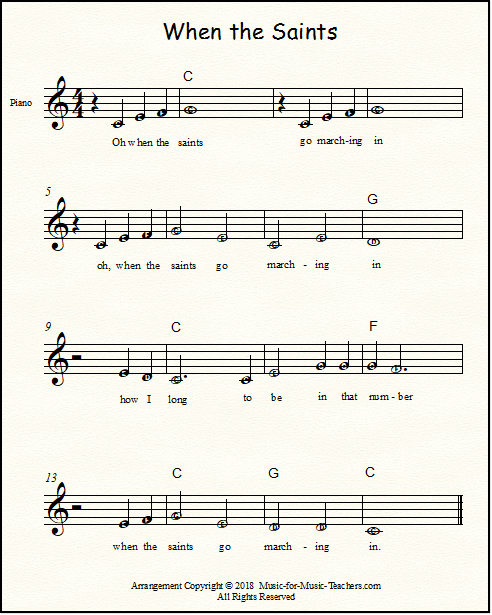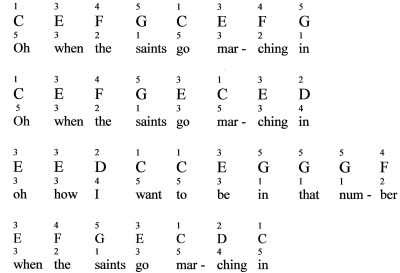“When the Saints Go Marching In” is a popular song easily arranged for piano. Numerous versions exist for beginners to advanced players.
The song “When the Saints Go Marching In,” often just referred to as “The Saints,” is a traditional gospel hymn that has seen widespread popularity beyond its religious origins, becoming a staple piece for jazz bands and a symbolic anthem for New Orleans’ musical heritage.
Its simple melody and repetitive structure make it an ideal choice for pianists of all skill levels. Originating as a spiritual tune, its uplifting message of salvation and hope has transcended cultural barriers. Piano players learn this tune not only for its historical significance but also for its joyful rhythm and ability to engage audiences. Whether in a music class, at a public performance, or home enjoyment, playing this song on the piano invokes a sense of joy and community, echoing the vibrant spirit of a marching band.
The Cultural Significance Of ‘when The Saints Go Marching In’
The song ‘When the Saints Go Marching In’ is more than just a popular tune. It’s a staple in music culture with deep roots. This melody has transcended its origins to become a symbol of joy and celebration the world over. It’s a cornerstone at festive parades and a hymn linked to the theme of eternal happiness.
Roots In Gospel And Jazz
‘When the Saints Go Marching In’ began as a gospel hymn. It expressed slaves’ hopes and spiritual desires during the late 19th century. The song’s uplifting spirit resonated with many who sought comfort and strength through music. Jazz musicians in the early 20th century adopted it. They infused it with the buoyant beats of New Orleans jazz. The song became a staple among jazz artists, solidifying its iconic status. Icons like Louis Armstrong brought it to the masses with unforgettable charm and energy.
- Inspiration drawn from African American spirituals
- Adaptation into the jazz genre
- Impact on popular culture through artists like Louis Armstrong
Adoption By New Orleans And Beyond
Beyond the jazz clubs, ‘When the Saints Go Marching In’ found a home in New Orleans’ streets. It became synonymous with Mardi Gras and other festive parades. Its infectious rhythm inspired millions to dance and celebrate life. Bands and musicians continue to keep the tradition alive. The song also showcases the resilience and vibrant culture of New Orleans after adversities like Hurricane Katrina.
| Mardi Gras Parades | Jazz Funerals | Cultural Celebrations |
|---|---|---|
| Icon of revelry | Soulful farewell | Global adoption |
The tune crosses borders, influencing artists from various genres worldwide. From traditional jazz to contemporary pop covers, its versatility knows no bounds. ‘When the Saints Go Marching In’ embodies the spirit of togetherness in music and society.

Credit: www.music-for-music-teachers.com
Melodic Charm And Rhythm
“When the Saints Go Marching In” is a tune that captures hearts with its simple, yet infectious melody. The song, often played on the piano, invites musicians of all levels to explore its tuneful charm. It is a melody that lingers, inviting foot-tapping rhythm and a humming along from listeners.
Dissecting The Tune
The beauty of “When the Saints Go Marching In” lies in its distinct melody. The notes follow a pattern that feels both familiar and uplifting. Upon dissecting the tune, one discovers its framework is easy to grasp:
- Scale-based runs: Utilize the major scale for a joyful sound.
- Repetition: Encourages quick learning and audience participation.
- Call-and-Response: Creates an engaging musical conversation.
The melody’s appeal is timeless and perfect for piano players to master and add their spin.
Syncopation And Swing In Piano Arrangements
When pianists introduce syncopation and swing, they infuse “When the Saints Go Marching In” with a new energy. Here’s how they do it:
- Offbeat accents: Break the predictability, sparking excitement.
- Swing rhythm: Alters the even rhythm to a long-short pattern.
- Dynamic contrast: Adds musical interest and depth to performance.
The right mix of syncopation and swing turns this familiar tune into a vibrant piano piece. Listeners can’t help but be drawn into the playful and lively interpretation.
Iconic Piano Interpretations
When the Saints Go Marching In, a melody rich in tradition, finds new life under the fingers of skilled pianists. Originating as a gospel hymn, it has transcended its roots to become a jazz staple. Each interpretation at the piano offers a unique celebration of this timeless classic.
Pioneers Of Stride And Their Styles
Stride piano, with its lively step and intricate bass, brought “When the Saints Go Marching In” into the jazz limelight. Pioneers such as Fats Waller and James P. Johnson led the way with their vibrant styles. This subgenre emphasized improvisation, swinging rhythms, and the left hand’s oomph.
- Fats Waller: A mix of humor and technique.
- James P. Johnson: Foundation of Harlem Stride.
- Willie “The Lion” Smith: Innovative and energetic.
Modern Takes And Variations
Inspired by these legends, contemporary musicians put their twist on an old favorite. Artists blend genres, incorporate new technologies, and personalize the tune. From Harry Connick Jr. to Jon Batiste, the song gains fresh perspectives.
| Artist | Style | Innovation |
|---|---|---|
| Harry Connick Jr. | New Orleans Jazz | Energetic performances |
| Jon Batiste | Modern Jazz | Creative improvisations |
| Dr. John | Rhythm and Blues | Distinctive gravelly voice |
Credit: musescore.com
Learning To Play ‘when The Saints Go Marching In’
Playing ‘When the Saints Go Marching In’ on piano is both exciting and rewarding. This traditional gospel hymn has charmed audiences for decades. Its simple melody and upbeat rhythm make it a perfect piece for beginners. Whether you’re a young learner or just young at heart, mastering this song can be your first step into the wonderful world of piano playing.
Basic Chords And Progression
The foundation of any song is its chords. ‘When the Saints Go Marching In’ typically uses three main chords: C Major, F Major, and G Major. These are often referred to as the I, IV, and V chords in the key of C. Playing these chords in progression builds the harmonic base of the song.
| Chord | Notes | Position |
|---|---|---|
| C Major | C-E-G | Root |
| F Major | F-A-C | Second |
| G Major | G-B-D | Third |
Incorporating Left Hand Techniques
With the right hand playing the melody, the left hand provides the accompaniment. Start with simple bass notes corresponding to each chord. Then, progress to left-hand chords or an arpeggiated pattern. This adds depth and rhythm to your playing.
- Bass note: Play the root note of each chord with your left hand.
- Chords: Use your left hand to play the full chord in sync with the melody.
- Arpeggios: Break the chords into single notes, played one at a time, to create a flowing sound.
Begin slowly, focusing on smooth transitions. Gradually increase speed as your comfort and skill grow.
Improvisation Techniques And Jazz Soloing
Are you ready to jazz up ‘When the Saints Go Marching In’ on piano? Great piano soloing breathes new life into this classic hymn. Playing a solo can feel like painting: your palette is full of musical notes and your brush can go anywhere. Let’s dive into the art of improvisation.
Building A Solo Around The Melody
The foundation of a memorable solo often lies in the melody. Start by playing the melody as is. This locks the tune in your mind and fingers. Then, embellish it with small changes. Add trills, change rhythms, or jump octaves. Keep the song’s core recognizable, but decorate it like a tree on Christmas.
- Play the melody straight.
- Introduce rhythm variations.
- Include octave jumps or trills.
Exploring Different Scales And Modes
Want to color outside the lines? Try different scales and modes! They are like new colors on your canvas. Each one creates a different mood and texture. Major scales feel happy and bright. Minor scales can be sad or cool. Blues scales add a soulful twist. Let’s experiment:
| Scale/Mode | Mood/Texture |
|---|---|
| Major | Bright, Happy |
| Minor | Sad, Cool |
| Blues | Soulful, Gritty |
Begin with the scale that fits the song’s key. Then, slide into others. Mix them up to create a unique taste. Rotate between the scales for variety. Think of it as a spice rack—each scale adds a different flavor to your musical dish.

Credit: www.true-piano-lessons.com
Incorporating Into Your Repertoire
Every musician aims to diversify their skill set. ‘When the Saints Go Marching In’ is a must-have for any pianist. The melody is iconic. The tune is timeless. Mastery of this piece can ignite any audience’s enthusiasm. Read on to discover how to make this song a staple of your piano repertoire.
Arrangement Tips For Solo Performance
Personalizing ‘When the Saints Go Marching In’ for solo piano can be thrilling. Here’s how to make your performance stand out:
- Variety is key: Mix chord textures. Use both blocked and broken chords.
- Add flair with runs: Embellish transitions. Create engaging dynamics.
- Pay attention to rhythm: Explore syncopation. Keep the left-hand groove solid.
Rework the classic to suit your style. Infuse it with unique improvisations.
Playing With A Band: Accompaniment Vs. Soloing
Playing ‘When the Saints Go Marching In’ with a band? Here’s your game plan:
| Accompaniment | Soloing |
|---|---|
| Keep the chords simple. Support the melody. | Bring out your inner creativity. Take center stage. |
| Listen actively. Blend with other instruments. | Understand the song structure. Know when to shine. |
| Ensure the timing is tight. Sync with the rhythm section. | Experiment with scales. Create memorable moments. |
Master both roles for a flexible performance. Lead confidently during solos. Deliver strong support when accompanying.
Do you have the sheet music for “When the Saints Go Marching in” for piano?
Sorry, I don’t have the sheet music for “When the Saints Go Marching in” for piano. However, you can check the piano schedule on channel 4 for any upcoming performances or piano tutorials. Good luck with your search!
Frequently Asked Questions On When The Saints Go Marching In Piano
When The Saints Come Marching In Piano Notes?
“Saints Come Marching In” piano notes typically include the melody in C Major, starting with the notes C4-E4-G4-C5-G4. For a complete sheet, search for “When the Saints Go Marching In piano sheet music. “
How Do You Play When The Saints Go Marching In On The Keyboard?
To play “When the Saints Go Marching In” on the keyboard, learn the song’s melody and chords. Start by mastering simple right-hand melodies, then incorporate left-hand chords to add harmony. Practice slowly, gradually increasing speed as you become familiar with the tune and transitions.
When The Saints Go Marching In Piano Tempo?
The traditional tempo for “When the Saints Go Marching In” on piano is moderately fast, around 160-200 beats per minute.
When The Saints Go Marching In Biblical Meaning?
“The Saints Go Marching In” alludes to the Second Coming of Jesus, when the righteous will enter Heaven, as described in the book of Revelation.
Conclusion
Mastering ‘When the Saints Go Marching In’ on the piano can be a delightful journey. It bridges the gap between tradition and musical exploration. Perfect for pianists of all levels, this tune promises to keep your fingers dancing. Let the iconic melody fill your space, inspiring joy with every note played.
Happy practicing!
